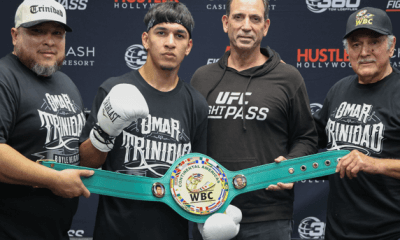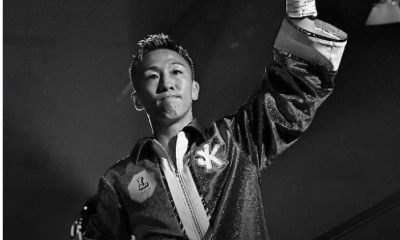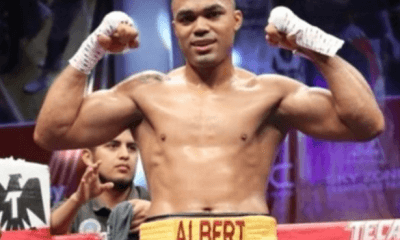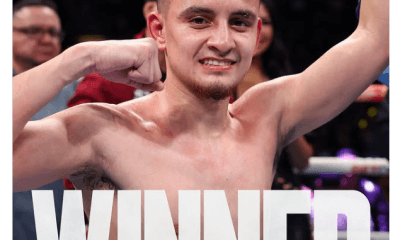Book Review
Ed Odeven’s New Book Pays Homage to Sports Journalist Jerry Izenberg
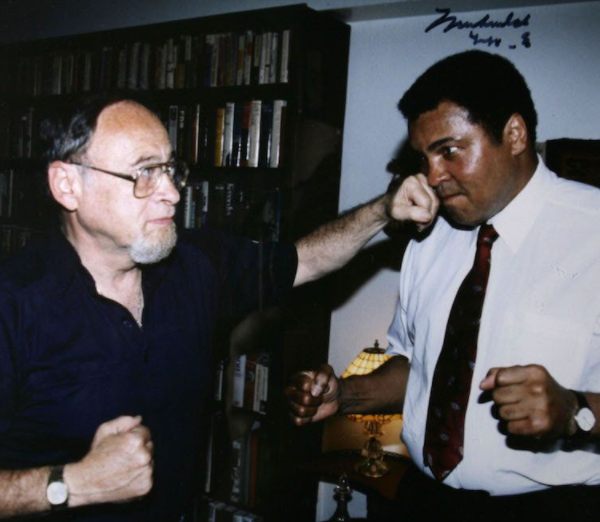
It’s one thing to get to the top, but it’s something else entirely to remain there for more than half a century. Jerry Izenberg, longtime sports columnist for the Newark Star-Ledger, now semi-retired and living in Henderson, Nevada, has done just that.
Izenberg is the subject of Ed Odeven’s book, “Going 15 Rounds With Jerry Izenberg,” which was released New Year’s Eve and is available at amazon.com.
“By all accounts, he should be recognized as one of the greatest American sports columnists,” said Odeven, a 1999 graduate of Arizona State University who has lived in Japan since July 2006 and is the sports editor for the website Japan Forward. “A versatile professional, he was equally skilled at writing books and magazine articles and producing sports documentaries and crafting essays for the groundbreaking ‘Sports Extra’ television program on Channel 5 in New York in the 1970s.”
Odeven went on: “Jerry has seen everything and been seemingly everywhere. He brought gravitas to the newspaper sports section with decades of sustained excellence.”
During a seven-decade career in sports journalism, the 90-year-old Izenberg, found time to write 15 non-fiction books and one novel. His affinity for the manly sport is reflected in his 2017 book, “Once There Were Giants: The Golden Age Of Heavyweight Boxing.”
“From the 1950s to the present day [including recent years’ coverage of Tyson Fury and Manny Pacquiao, for instance, Izenberg has shined in his boxing coverage,” Odeven said. “You can’t ignore his remembrance pieces on fighters and boxing personalities across the decades [such as a terrific column on the late Leon Spinks in which he weaved a tapestry of the fighter’s life and his family’s struggles into a powerful piece], either.”
One of Izenberg’s favorite topics is Muhammad Ali.
“Izenberg first observed the great fighter’s infectious personality, popularity and boxing talent on display at the 1960 Rome Olympics,” Odeven said. “Cassius Clay was unlike any other famous pugilist in those days and for the rest of his life.”
Odeven spoke about the support Ali received from Izenberg: “When very few were publicly taking a stand to support Ali, Izenberg wrote columns that defended his right to fight. He took the boxing establishment to task for stripping Ali of his titles even while Ali’s case was making its way through the courts – and ultimately the United States Supreme Court.”
Izenberg, a graduate of Rutgers University who covered the first 53 Super Bowls, and Ali were close. “As friends, they were around each other in all corners of the earth,” Odeven said. “They shared highs and lows during periods of personal and professional success and disappointment.”
Here’s Jerry Izenberg talking about Ali’s humanity: “I was a single father and when my children came to live with me, they were very nervous. I took them to Deer Lake [Pennsylvania] for a television show I was filming as an advance to the Foreman-Ali fight. After the filming, knowing my situation, (Ali) took my son aside and put his arm around him and said, “Robert, you have come to live with a great man. Listen to him and you will grow to be a great man just like him.
“On the way up my daughter, who was seven, had said, ‘I hope Foreman beats him up because he brags too much and you always told me to not brag.’ “I told her, ‘you are seven and you have nothing to brag about. Both of these men are my friends. When you get there, keep your mouth shut.’ When we were packing up the equipment, he saw her in the back of the room and hollered, ‘come up here little girl. You with the braids.’ She was convinced I had ratted her out about what she said and tried her best to melt into the wall because she was frightened. As she walked toward him, she lost the power of speech and mumbled. He was 6-3 and she was 4-5. He grabbed her and held her over his head. ‘Is that man your daddy?’ All she could do was nod. ‘Don’t you lie to me little girl, look at him,’ and he pointed at me. ‘That man is ugly…ugly. You are beautiful, now gimme a kiss.’ On the way home she said, ‘I hope Muhammad can win,’ and I said, ‘you are just like the rest of them. The only difference is your age.’ He was one of my five best friends. When he died, I cried.”
Odeven offered his slant on why Izenberg was at home at major boxing events: “It was clear that Jerry was in a comfort zone on the week of a big fight, writing the stories that set the stage for the mano a mano encounter and the follow-up commentary that defined what happened and what it meant.”
Izenberg, noted Odeven, had worked under the legendary Stanley Woodward, as had Red Smith and Roger Kahn, among others, the latter most well-known for having penned the baseball classic, “The Boys Of Summer.” Many insist that Woodward, who read the classics, was the greatest sports editor.
Woodward, Odenven believes, helped shape Izenberg’s world outlook. “Izenberg became keenly aware of this human drama at its rawest form that existed in boxing,” he said, noting that in decades past the public was captivated by the big fights. “Examples, of course, include the first and third Ali-Frazier bouts and The Rumble In The Jungle [against Foreman]. Let’s not forget they were cultural touchstones.”
Referencing the third installment of Ali-Frazier in Manila, Izenberg said, “I’ve probably seen thousands of fights, but I never saw one when both fighters were exhausted and just wouldn’t quit…My scorecard had Ali ahead by one which meant if Joe knocked him down in the 15th, he would have won on my card. But there was no 15th because Joe’s trainer, Eddie Futch, ordered the gloves cut off after the 14th.
“At the finish, Ali collapsed. Later as Ali walked slowly up the aisle supported by his seconds, he leaned over toward the New York Times’ Dave Anderson and me and said through puffy lips, ‘Fellas. That’s the closest you will ever see to death.’”
Izenberg remembered his lead: “Muhammad Ali and Joe Frazier did not fight for the WBC heavyweight title last night,” he wrote. “They did not fight for the heavyweight championship of the planet. They could have fought in a telephone booth on a melting ice flow. They were fighting for the championship of each other and for me that still isn’t settled.”
What makes Izenberg relevant even today? “His canvas was the global sports landscape and he explored the human condition in each of his columns in some way,” Odeven stated. “He recognized what made a good story and sought out individuals and topics that fit that description – and he still does.
“You could read a random stack of columns about any number of topics from the 1960s or ’90s and be enlightened and entertained at the same time…He has always had a razor- sharp eye for details that illuminate a column and a source’s words to give it added verve.” Moreover, added Odeven, Izenberg had a never-wavering commitment to championing a just cause: “Speaking out against racism and religious bigotry, he gave a voice to the voiceless or those often ignored.”
Note: Jerry Izenberg was inducted into the International Boxing Hall of Fame in the Observer category in 2015.
To comment on this story in the Fight Forum CLICK HERE
-

 Featured Articles3 weeks ago
Featured Articles3 weeks agoThe Hauser Report: Zayas-Garcia, Pacquiao, Usyk, and the NYSAC
-

 Featured Articles2 weeks ago
Featured Articles2 weeks agoOscar Duarte and Regis Prograis Prevail on an Action-Packed Fight Card in Chicago
-

 Featured Articles1 week ago
Featured Articles1 week agoThe Hauser Report: Cinematic and Literary Notes
-

 Book Review3 days ago
Book Review3 days agoMark Kriegel’s New Book About Mike Tyson is a Must-Read
-
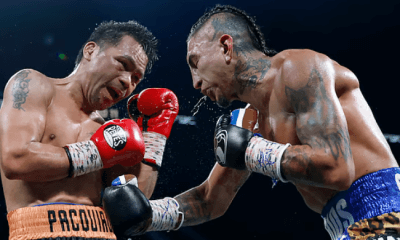
 Featured Articles4 weeks ago
Featured Articles4 weeks agoManny Pacquiao and Mario Barrios Fight to a Draw; Fundora stops Tim Tszyu
-
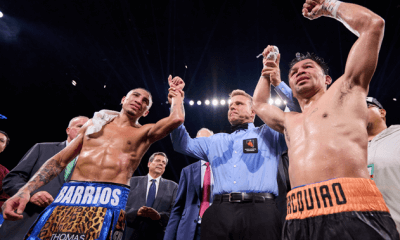
 Featured Articles3 weeks ago
Featured Articles3 weeks agoArne’s Almanac: Pacquiao-Barrios Redux
-

 Featured Articles2 weeks ago
Featured Articles2 weeks agoRemembering Dwight Muhammad Qawi (1953-2025) and his Triumphant Return to Prison
-
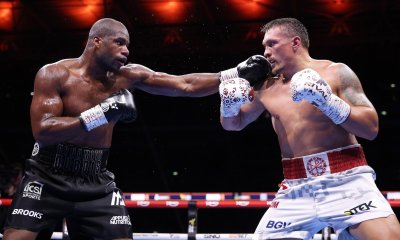
 Featured Articles4 weeks ago
Featured Articles4 weeks agoOleksandr Usyk Continues to Amaze; KOs Daniel Dubois in 5 One-Sided Rounds


